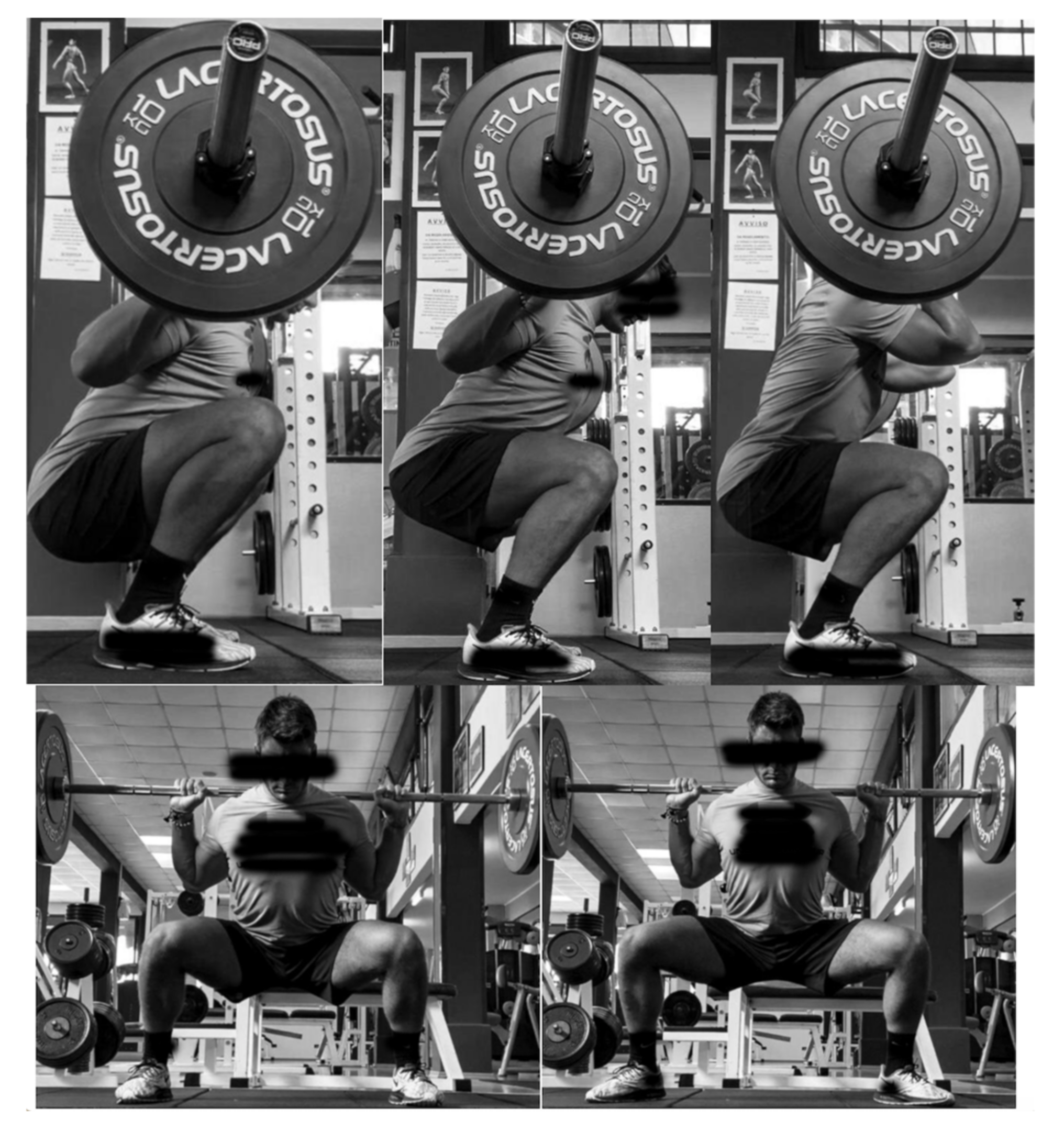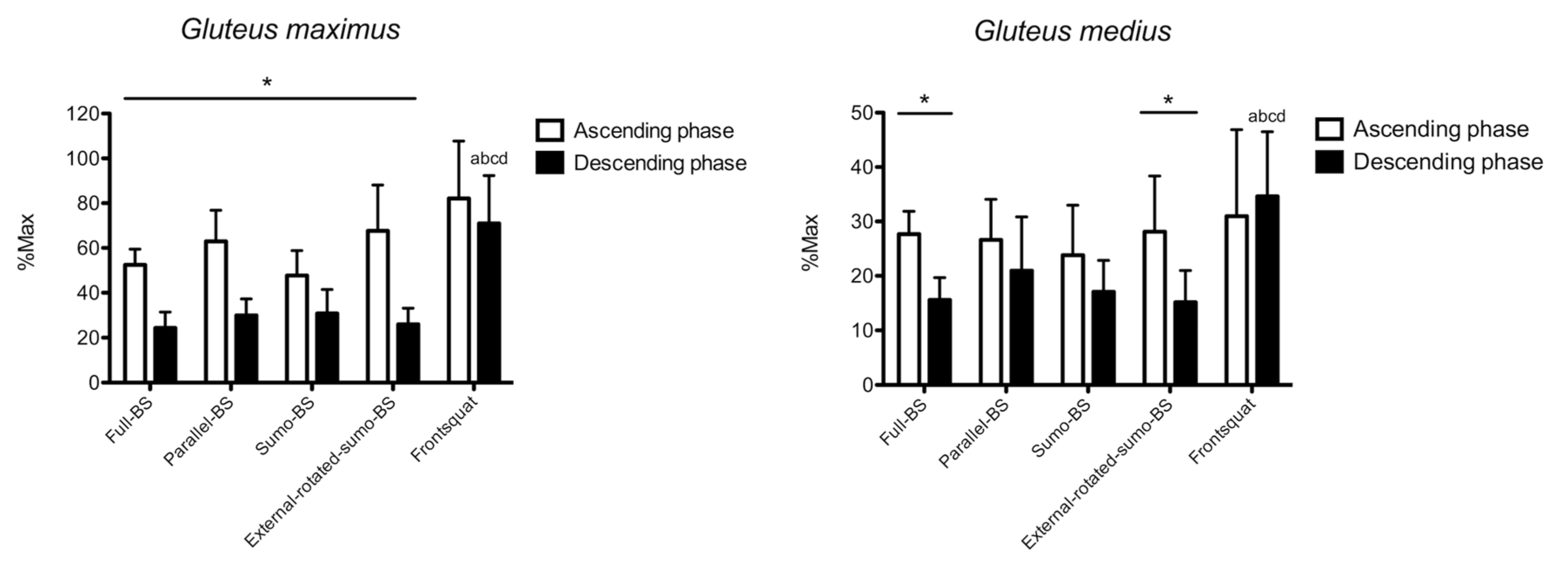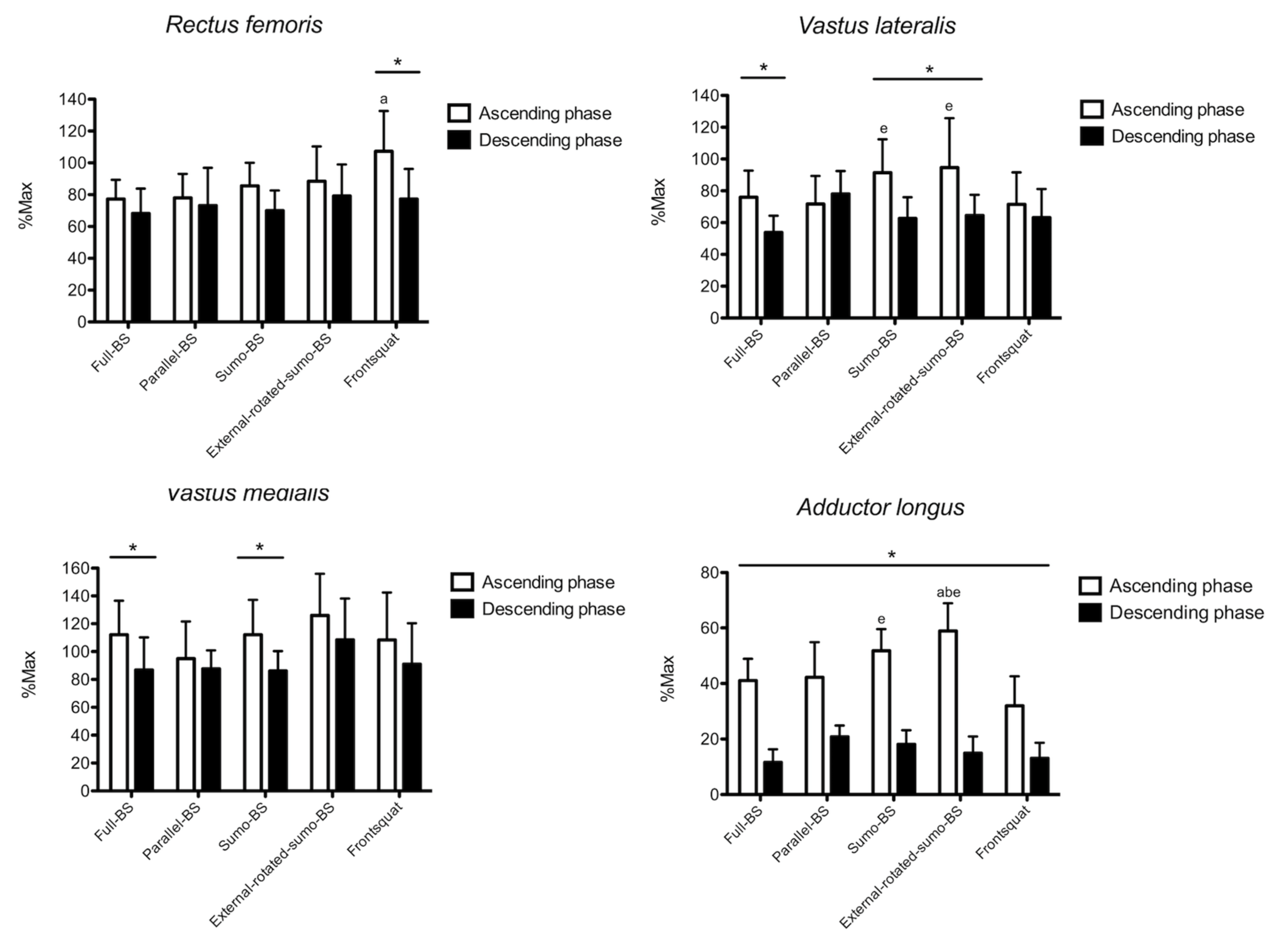The Activation of Gluteal, Thigh, and Lower Back Muscles in Different Squat Variations Performed by Competitive Bodybuilders: Implications for Resistance Training
Abstract
1. Introduction
2. Materials and Methods
2.1. Study Design
2.2. Participants
2.3. Maximum Voluntary Isometric Activation
2.4. 1-RM Protocol
2.5. Exercises’ Technique Description
2.6. Data Analysis
2.7. Statistical Analysis
3. Results
4. Discussion
4.1. Gluteal Muscles
4.2. Thigh Muscles
4.3. Lower Back Muscles
4.4. Limitations
5. Conclusions
Author Contributions
Funding
Institutional Review Board Statement
Informed Consent Statement
Data Availability Statement
Acknowledgments
Conflicts of Interest
References
- Kubo, K.; Ikebukuro, T.; Yata, H. Effects of squat training with different depths on lower limb muscle volumes. Eur. J. Appl. Physiol. 2019, 119, 1933–1942. [Google Scholar] [CrossRef] [PubMed]
- Coratella, G.; Beato, M.; Cè, E.; Scurati, R.; Milanese, C.; Schena, F.; Esposito, F. Effects of in-season enhanced negative work-based vs traditional weight training on change of direction and hamstrings-to-quadriceps ratio in soccer players. Biol. Sport 2019, 36, 241–248. [Google Scholar] [CrossRef] [PubMed]
- Vanderka, M.; Longova, K.; Olasz, O.; Krčmár, M.; Walker, M. Improved Maximum Strength, Vertical Jump and Sprint Performance after 8 Weeks of Jump Squat Training with Individualized Loads. J. Sports Sci. Med. 2016, 15, 492–500. [Google Scholar]
- Slater, L.V.; Hart, J.M. Muscle Activation Patterns during Different Squat Techniques. J. Strength Cond. Res. 2017, 31, 667–676. [Google Scholar] [CrossRef]
- Clark, D.R.; Lambert, M.I.; Hunter, A.M. Muscle activation in the loaded free barbell squat: A brief review. J. Strength Cond. Res. 2012, 26, 1169–1178. [Google Scholar] [CrossRef]
- Hamlyn, N.; Behm, D.G.; Young, W.B. Trunk muscle activation during dynamic weight-training exercises and isometric instability activities. J. Strength Cond. Res. 2007, 21, 1108–1112. [Google Scholar] [CrossRef]
- Caterisano, A.; Moss, R.F.; Pellinger, T.K.; Woodruff, K.; Lewis, V.C.; Booth, W.; Khadra, T. The effect of back squat depth on the EMG activity of 4 superficial hip and thigh muscles. J. Strength Cond. Res. 2002, 16, 428–432. [Google Scholar] [CrossRef]
- Glassbrook, D.J.; Helms, E.R.; Brown, S.R.; Storey, A.G. A Review of the Biomechanical Differences between the High-Bar and Low-Bar Back-Squat. J. Strength Cond. Res. 2017, 31, 2618–2634. [Google Scholar] [CrossRef]
- Saeterbakken, A.H.; Stien, N.; Pedersen, H.; Andersen, V. Core Muscle Activation in Three Lower Extremity With Different Stability Requirements. J. Strength Cond. Res. 2019. Publish Ahead of Print. [Google Scholar] [CrossRef]
- Gullett, J.C.; Tillman, M.D.; Gutierrez, G.M.; Chow, J.W. A biomechanical comparison of back and front squats in healthy trained individuals. J. Strength Cond. Res. 2008, 23, 284–292. [Google Scholar] [CrossRef]
- Paoli, A.; Marcolin, G.; Petrone, N. The effect of stance width on the electromyograhycal activity of eight superficial thigh muscles during back squat with different bar loads. J. Strength Cond. Res. 2009, 23, 246–250. [Google Scholar] [CrossRef] [PubMed]
- Da Silva, J.J.; Schoenfeld, B.J.; Marchetti, P.N.; Pecoraro, S.L.; Greve, J.M.D.; Marchetti, P.H. Muscle activation differs between partial and full back squat exercise with external load equated. J. Strength Cond. Res. 2017, 31, 1688–1693. [Google Scholar] [CrossRef] [PubMed]
- Contreras, B.; Vigotsky, A.D.; Schoenfeld, B.J.; Beardsley, C.; Cronin, J. A comparison of gluteus maximus, biceps femoris, and vastus lateralis electromyography amplitude for the barbell, band, and American hip thrust variations. J. Appl. Biomech. 2016, 32, 254–260. [Google Scholar] [CrossRef] [PubMed]
- Trindade, T.B.; De Medeiros, J.A.; Dantas, P.M.S.; De Oliveira Neto, L.; Schwade, D.; De Brito Vieira, W.H.; Oliveira-Dantas, F.F. A comparison of muscle electromyographic activity during different angles of the back and front squat. Isokinet. Exerc. Sci. 2019, 28, 1–8. [Google Scholar] [CrossRef]
- McCaw, S.T.; Melrose, D.R. Stance width and bar load effects on leg muscle activity during the parallel squat. Med. Sci. Sports Exerc. 1999, 31, 428–436. [Google Scholar] [CrossRef] [PubMed]
- Coratella, G.; Tornatore, G.; Longo, S.; Esposito, F.; Cè, E. Specific prime movers’ excitation during free-weight bench press variations and chest press machine in competitive bodybuilders. Eur. J. Sport Sci. 2019, 1–22. [Google Scholar] [CrossRef]
- Coratella, G.; Tornatore, G.; Longo, S.; Esposito, F. An electromyographic analysis of lateral raise variations and frontal raise in competitive bodybuilders. Int. J. Environ. Res. Public Health 2020, 17, E6015. [Google Scholar] [CrossRef]
- Coratella, G.; Bertinato, L. Isoload vs isokinetic eccentric exercise: A direct comparison of exercise-induced muscle damage and repeated bout effect. Sport Sci. Health 2015, 11, 87–96. [Google Scholar] [CrossRef]
- Coratella, G.; Chemello, A.; Schena, F. Muscle damage and repeated bout effect induced by enhanced eccentric squats. J. Sports Med. Phys. Fitness 2016, 56, 1540–1546. [Google Scholar]
- Coratella, G.; Milanese, C.; Schena, F. Unilateral eccentric resistance training: A direct comparison between isokinetic and dynamic constant external resistance modalities. Eur. J. Sport Sci. 2015, 15, 720–726. [Google Scholar] [CrossRef]
- Coratella, G.; Schena, F. Eccentric resistance training increases and retains maximal strength, muscle endurance, and hypertrophy in trained men. Appl. Physiol. Nutr. Metab. 2016, 41, 1184–1189. [Google Scholar] [CrossRef] [PubMed]
- Coratella, G.; Milanese, C.; Schena, F. Cross-education effect after unilateral eccentric-only isokinetic vs dynamic constant external resistance training. Sport Sci. Health 2015, 11, 329–335. [Google Scholar] [CrossRef]
- Hermens, H.J.; Freriks, B.; Disselhorst-Klug, C.; Rau, G. Development of recommendations for SEMG sensors and sensor placement procedures. J. Electromyogr. Kinesiol. 2000, 10, 361–374. [Google Scholar] [CrossRef]
- Merlo, A.; Campanini, I. Technical Aspects of Surface Electromyography for Clinicians. Open Rehabil. J. 2010, 3, 98–109. [Google Scholar] [CrossRef]
- Delmore, R.J.; Laudner, K.G.; Torry, M.R. Adductor longus activation during common hip exercises. J. Sport Rehabil. 2014, 23, 79–87. [Google Scholar] [CrossRef]
- Coratella, G.; Beato, M.; Milanese, C.; Longo, S.; Limonta, E.; Rampichini, S.; Cè, E.; Bisconti, A.V.; Schena, F.; Esposito, F. Specific Adaptations in Performance and Muscle Architecture After Weighted Jump-Squat vs. Body Mass Squat Jump Training in Recreational Soccer Players. J. Strength Cond. Res. 2018, 32, 921–929. [Google Scholar] [CrossRef]
- Coratella, G.; Tornatore, G.; Longo, S.; Borrelli, M.; Doria, C.; Esposito, F.; Cè, E.; Coratella, G.; Tornatore, G.; Longo, S.; et al. The Effects of Verbal Instructions on Lower Limb Muscles’ Excitation in Back-Squat. Res. Q. Exerc. Sport 2020, 1–7. [Google Scholar] [CrossRef]
- Hopkins, W.G.; Marshall, S.W.; Batterham, A.M.; Hanin, J. Progressive Statistics for Studies in Sports Medicine and Exercise Science. Med. Sci. Sport. Exerc. 2009, 41, 3–13. [Google Scholar] [CrossRef]
- Yavuz, H.U.; Erdağ, D.; Amca, A.M.; Aritan, S. Kinematic and EMG activities during front and back squat variations in maximum loads. J. Sports Sci. 2015, 33, 1058–1066. [Google Scholar] [CrossRef]
- Alves, R.C.; Prestes, J.; Enes, A.; Moraes, W.M. Training Programs Designed for Muscle Hypertrophy in Bodybuilders: A Training Programs Designed for Muscle Hypertrophy in Bodybuilders: A Narrative Review. Sports 2020, 8, 149. [Google Scholar] [CrossRef]
- Wretenberg, P.; Feng, Y.I.; Arborelius, U.P. High- and low-bar squatting techniques during weight-training. Med. Sci. Sports Exerc. 1996, 28, 218–224. [Google Scholar] [CrossRef] [PubMed]
- Alves, D.; Matta, T.; Oliveira, L. Effect of shoulder position on triceps brachii heads activity in dumbbell elbow extension exercises. J. Sports Med. Phys. Fitness 2018, 58, 1247–1252. [Google Scholar] [CrossRef] [PubMed]
- Signorile, J.F.; Rendos, N.K.; Heredia Vargas, H.H.; Alipio, T.C.; Regis, R.C.; Eltoukhy, M.M.; Nargund, R.S.; Romero, M.A. Differences in muscle activation and kinematics between cable-based and selectorized weight training. J. Strength Cond. Res. 2017, 31, 313–322. [Google Scholar] [CrossRef] [PubMed]
- Boyden, G.; Kingman, J.; Dyson, R. A Comparison of Quadriceps Electromyographic Activity with the Position of the Foot during the Parallel Squat. J. Strength Cond. Res. 2000, 14, 379–382. [Google Scholar] [CrossRef]
- Pereira, G.L.; Leporace, G.; Das Virgens Chabas, D.; Furtado, L.F.L.; Praxedes, J.; Batista, L.A. Influence of hip external rotation on hip adductor and rectus femoris myoelectric activity during a dynamic parallel squat. J. Strength Cond. Res. 2010, 24, 2749–2754. [Google Scholar] [CrossRef]
- Signorile, J.F.; Kwiatkowski, K.; Caruso, J.F.; Robertson, B. Effect of foot position on the electromyographical activity of the superficial quadriceps muscles during the parallel squat and knee extension. J. Strength Cond. Res. 1995, 9, 182–187. [Google Scholar]




Publisher’s Note: MDPI stays neutral with regard to jurisdictional claims in published maps and institutional affiliations. |
© 2021 by the authors. Licensee MDPI, Basel, Switzerland. This article is an open access article distributed under the terms and conditions of the Creative Commons Attribution (CC BY) license (http://creativecommons.org/licenses/by/4.0/).
Share and Cite
Coratella, G.; Tornatore, G.; Caccavale, F.; Longo, S.; Esposito, F.; Cè, E. The Activation of Gluteal, Thigh, and Lower Back Muscles in Different Squat Variations Performed by Competitive Bodybuilders: Implications for Resistance Training. Int. J. Environ. Res. Public Health 2021, 18, 772. https://doi.org/10.3390/ijerph18020772
Coratella G, Tornatore G, Caccavale F, Longo S, Esposito F, Cè E. The Activation of Gluteal, Thigh, and Lower Back Muscles in Different Squat Variations Performed by Competitive Bodybuilders: Implications for Resistance Training. International Journal of Environmental Research and Public Health. 2021; 18(2):772. https://doi.org/10.3390/ijerph18020772
Chicago/Turabian StyleCoratella, Giuseppe, Gianpaolo Tornatore, Francesca Caccavale, Stefano Longo, Fabio Esposito, and Emiliano Cè. 2021. "The Activation of Gluteal, Thigh, and Lower Back Muscles in Different Squat Variations Performed by Competitive Bodybuilders: Implications for Resistance Training" International Journal of Environmental Research and Public Health 18, no. 2: 772. https://doi.org/10.3390/ijerph18020772
APA StyleCoratella, G., Tornatore, G., Caccavale, F., Longo, S., Esposito, F., & Cè, E. (2021). The Activation of Gluteal, Thigh, and Lower Back Muscles in Different Squat Variations Performed by Competitive Bodybuilders: Implications for Resistance Training. International Journal of Environmental Research and Public Health, 18(2), 772. https://doi.org/10.3390/ijerph18020772








